2. 中国地质调查局前寒武纪地质研究中心, 天津 300170;
3. 中国科学院地质与地球物理研究所, 岩石圈演化国家重点实验室, 北京 100029
2. Precambrian Geological Research Centre, China Geological Survey, Tianjin 300170, China;
3. State Key Laboratory of Lithospheric Evolution, Institute of Geology and Geophysics, Chinese Academy of Sciences, Beijing 100029, China
国际地层表中将古元古代与中元古代的界线置于1600Ma,而我国长期以来仍将这一界线置于1800Ma(全国地层委员会, 1981, 2002)。近几年,随着研究手段的进步和认识水平的提高,国际地层委员会开始倡议以类似于显生宙地层研究所采用的“金钉子”方法,即以现存的岩石记录(重大地质事件)标定前寒武纪地层界线(Gradstein et al., 2004;苏文博,2014)。从1800Ma至1600Ma,全球构造格局、古地理环境和生物演化发生了巨大变革(赵太平等, 2015),这一时期Columbia超大陆的汇聚和裂解事件尤为突出,因此,Columbia超大陆的汇聚与紧随其后的裂解事件应作为划分古/中元古代界线的标志(Gradstein et al., 2004;耿元生等, 2019;赵太平等,2019)。目前学术界对Columbia超大陆是在2.0~1.85Ga全球规模的碰撞造山事件中拼合而成的认识已经基本达成一致(Condie, 2002;Rogers and Santosh, 2002;Zhao et al., 2002b, 2004;陆松年等, 2002;李江海等, 2004),而对其初始裂解的时限因地域差别有很大争议,这也是造成国际上关于古/中元古代界线与中国相差200Myr的原因之一。Columbia超大陆的初始裂解被认为始于1.6Ga,裂解的高潮发生在1.4~1.2Ga(Ernst et al., 2008)。作为Columbia超大陆的组成部分,华北克拉通经历了完整的汇聚与裂解过程,众多学者认为~1.78Ga的大规模基性岩墙群、熊耳群等火山岩及火山沉积岩和1.72~1.67Ga的AMCG组合(斜长岩-纹长二长岩-紫苏花岗岩-环斑花岗岩)等非造山岩浆活动为华北克拉通化初始裂解的标志(Lu et al., 2002, 2008;陆松年等, 2002;翟明国, 2004;Hou et al., 2008);侯贵廷(2012)根据华北地区基性岩墙群的研究认为华北克拉通在~1.85Ga就已经开始裂解;Peng et al.(2007, 2008)、Peng (2010)认为这些岩墙群与熊耳群火山岩可能是大火成岩省的产物,进而提出地幔柱演化模式。但是也有学者认为熊耳群火山岩的地球化学数据显示钙碱性特点,形成于大陆边缘弧环境,并非板内裂解的产物(He et al., 2009;Zhao et al., 2009a)。同时,针对华北克拉通北缘AMCG组合的构造背景也存在不同的争论,多数学者坚持AMCG岩石组合为非造山岩浆作用的产物(Tapani Rämö et al., 1995;郁建华等, 1996;陆松年等, 2002, 2003;解广轰, 2005;杨进辉等, 2005;Lu et al., 2008;Jiang et al., 2011),但是也有学者认为其可能为后碰撞或后造山期伸展环境下的产物(Zhang et al., 2007;Liu et al., 2011;Wang et al., 2013a)。由此看来,1.8~1.6Ga期间,华北克拉通不仅在对Columbia超大陆裂解事件的响应时限上因地而异,而且对非造山岩浆活动构造背景的认识也不尽相同。
A型花岗岩因其特殊的岩石成因、构造背景和地球动力学意义而受到广泛关注(Eby,1990;贾小辉等, 2009)。目前报道的A型花岗岩几乎都形成于伸展背景下(Frost et al., 2007;Zhao and Zhou, 2009;张旗等, 2012),是响应超大陆裂解事件的最重要的标志之一。阴山东五分子地区白云常合山A型花岗岩岩体因其在空间上和成因上均与金矿成矿密切相关而受到关注。有学者认为其属于东五分子花岗-绿岩带的组成部分,并测得其成岩年龄为1648±3Ma(吉林大学同位素室测试, 1986, 转张洪涛,1992)。张洪涛(1992)通过K-Ar法测得岩体的侵位时代为240Ma,与金矿化年龄较为一致。笔者近来对该岩体进行了详细的年代学和地球化学研究,辅之以锆石Hf同位素分析,初步确定其形成于非造山的伸展构造环境,应是Columbia超大陆裂解事件在华北克拉通的响应。由此,对其岩石成因、岩浆源区和深部动力学过程的探索,可以为华北克拉通1.8~1.6Ga非造山岩浆活动的构造背景提供重要信息,也同时为阴山地区中元古代的初始裂解提供重要约束。
1 区域地质背景及岩石学特征研究区位于内蒙古固阳县东五分子地区,大地构造上处于两个早前寒武纪大地构造单元的结合带附近,南侧属于大青山-乌拉山孔兹岩带,北侧属于阴山地块(Zhao et al., 2005)(图 1a)。两者之间以韧性剪切带或断裂构造分隔,是区域上佘太-下湿壕-武川大型韧性剪切带的一部分(王惠初等,1999)。南侧孔兹岩带岩石组成较复杂,主要由乌拉山岩群变质表壳岩及再造杂岩构成,其中乌拉山岩群上亚群具有孔兹岩系特征,由榴云片麻岩、石墨片麻岩、钙硅酸盐和镁质大理岩等组成;乌拉山岩群下亚群主要由斜长角闪岩、黑云角闪片麻岩、黑云长英片麻岩等组成,原岩主要为一套基性-中酸性火山岩建造。与之伴生的再造杂岩主要为深熔片麻岩,如石榴花岗片麻岩、眼球状花岗片麻岩、紫苏花岗岩质-紫苏花岗闪长质-紫苏斜长花岗质-紫苏石英闪长质片麻岩(徐仲元等,2007)。北侧的阴山地块主要由东五分子花岗岩-绿岩带构成,其中的绿岩带为新太古代色尔腾山岩群含铁建造,自下而上岩石组合为斜长角闪岩夹类科马提质岩石与BIF建造、互层的变质安山岩和流纹岩夹少量基性火山岩、变粒岩-石英岩夹大理岩。色尔腾山岩群原岩建造应是基性火山岩-火山碎屑岩-含硅铁质沉积岩的组合,其变质程度达角闪岩相。花岗质岩石主要为新太古代TTG片麻岩(闪长岩-石英闪长岩-英云闪长岩-奥长花岗岩组合)和片麻状二长花岗岩,部分石英闪长质片麻岩具有赞岐岩特征(简平等,2005)。孔兹岩带被认为是阴山地块与鄂尔多斯地块在1.95~1.90Ga期间碰撞拼合的造山带(Zhao et al., 2005)。古元古代碰撞造山后,中元古代伊始,渣尔泰-白云鄂博裂陷槽逐渐打开,在本区沉积了渣尔泰群,从下到上划分为书记沟组(Chs)、增隆昌组(Chz)和阿古鲁沟组(Cha)。书记沟组是一套河流相沉积的石英砂岩-砾岩,以角度不整合形式覆盖在早前寒武纪变质基底之上;其上被增隆昌组整合覆盖,增隆昌组下部为碎屑岩建造,上部发育碳酸盐岩,属于滨海相沉积;阿古鲁沟组以细碎屑沉积为主,中部出现碳酸盐岩建造,显示浅海相沉积的特点。显示出裂谷带逐渐打开,沉积物由河流相转变为浅海相的海进过程。

|
图 1 研究区位置(a,据Zhao et al., 2005)及内蒙古固阳东五分子地区地质图(b) Fig. 1 Studied area location (a, after Zhao et al., 2005) and geological map of Dongwufenzi area, Guyang, Inner Mongolia (b) |
白云常合山花岗岩岩体位于东五分子村南3km处,东西长约5km,南北宽约3km,面积约12km2,侵入新太古代色尔腾山岩群和片麻状二长花岗岩中,与中元古代渣尔泰山群呈断层接触关系(图 1b)。在东五分子-狼窝壕-金家窑子一带,断续出露有与之岩性相近的中元古代二长花岗岩和正长花岗岩。本次工作从白云常合山岩体采集的岩石样品主要为碱长花岗岩和黑云母正长花岗岩,其中,黑云母正长花岗岩位于岩体靠中心位置,碱长花岗岩位于岩体边缘。
变质碱长花岗岩新鲜面为肉红色中-粗粒似斑状花岗岩,花岗变晶结构,块状构造,主要组成矿物为钾长石、石英、斜长石、磁铁矿(图 2a, b)。其中,钾长石含量~70%,呈近半自形板状,大部分为2~5mm,少部分为5~10mm,杂乱状分布,为微斜长石,轻高岭土化,交代斜长石;石英呈他形粒状,含量~20%,已重结晶,呈集合体状填隙于长石粒间,粒径一般0.1~1.5mm,呈现波状消光;斜长石含量较少,~5%,呈近半自形板状,粒径<1.5mm,零散状分布,为更长石,表面较干净,有的轻微破碎状;磁铁矿呈黑色粒状,含量3~5%;见少量被褐铁矿充填的晚期裂纹,少量碳酸盐零散状交代岩石。变质黑云母正长花岗岩呈灰白色,花岗变晶结构,块状构造,主要由钾长石、斜长石、石英、黑云母组成(图 2c, d)。其中,钾长石含量~60%,主要为微斜长石,部分残留近半自形板状,大小多为2~5mm,少量为5~10mm,晶体内显微裂隙发育,嵌有少量斜长石、石英,杂乱分布;石英含量~25%,多呈压扁、拉长集合体状,粒度0.2~1.0mm,多具波状、带状消光,粒间呈齿状粒状镶嵌;斜长石含量~10%,呈他形粒状,多呈细粒集合体状,大小多为0.1~0.3mm,0.3~1.0mm少见,可见聚片双晶,具绢云母化、土化,多被钠长石、石英交代,杂乱分布;黑云母含量~5%,多细粒化且呈集合体状,大小多为0.1~0.5mm,少量为0.5~1.0mm,绿褐色。
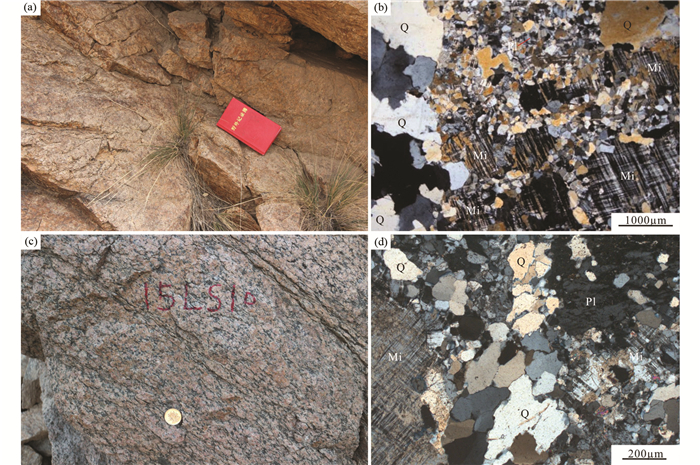
|
图 2 白云常合山A型花岗岩的岩相学特征 (a、b)碱长花岗岩;(c、d)黑云正长花岗岩.Mi-微斜长石;Q-石英;Pl-斜长石 Fig. 2 Petrography of the A-type granites in the Baiyunchanghe Mountain (a, b) alkali feldspar granite; (c, d) biotite syenogranite. Mi-microcline; Q-quartz; Pl-plagioclase |
岩石主、微量元素的分析测试由天津地质调查中心实验测试室完成。主量元素分析采用X射线荧光光谱法(XRF),分析精度优于3%,其中FeO采用湿化学法分析。微量元素和稀土元素分析使用电感耦合等离子体质谱法(ICP-MS),分析精度和准确度均高于5%。本次工作共采集岩石样品12件,化学成分分析结果见表 1。
|
|
表 1 固阳地区白云常合山A型花岗岩主量元素(wt%)和微量元素(×10-6)分析结果 Table 1 Major (wt%) and trace (×10-6) elements compositions of the A-type granite in the Baiyunchanghe Mountain, Guyang area |
白云常合岩体具有高硅(70.68%~77.21%,平均值为73.99%)、富碱(Na2O+K2O=7.88%~9.21%,K2O/Na2O=0.72~1.61,仅有1个样品低于1,平均值为1.28),贫Al2O3(11.70%~13.23%,平均值12.43%)、MgO(0.06%~0.24%)和CaO(0.23%~1.20%)的特征,Fe2O3T/MgO值较高,为12.60~90.38。通过岩浆岩系列硅碱图判别,样品均属于高钾钙碱性系列的花岗岩(图 3)。铝指数ASI(aluminium saturation index)=0.91~1.11,岩石为准铝质至弱过铝质花岗岩(图 4)。在花岗岩R1-R2图解中可见,样品都落在碱性花岗岩和正长花岗岩的区域内(图 5)。
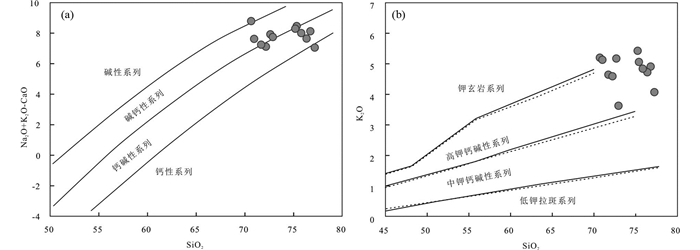
|
图 3 白云常合山A型花岗岩的SiO2-(Na2O+K2O-CaO)(a,据Frost et al., 2001)和SiO2-K2O(b,据Rollinson, 1993)图解 Fig. 3 The SiO2 vs. (Na2O+K2O-CaO) (a, after Frost et al., 2001) and SiO2 vs. K2O (b, after Rollinson, 1993) diagrams for A-type granites in the Baiyunchanghe Mountain |
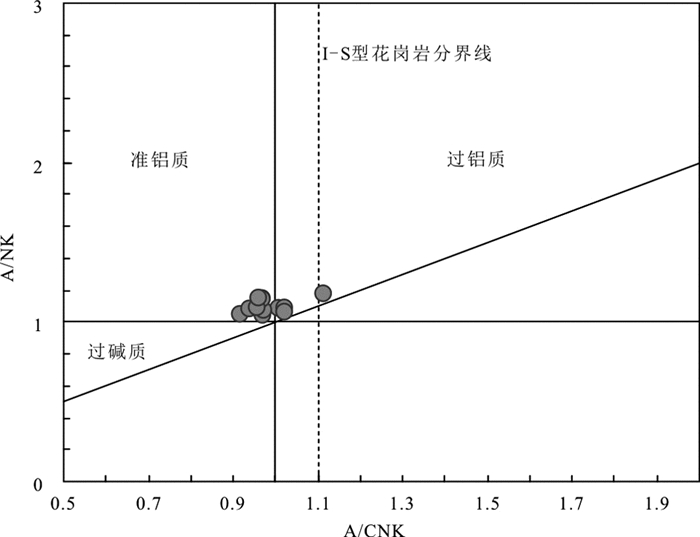
|
图 4 白云常合山A型花岗岩A/CNK-A/NK图解(底图据Shand, 1950) Fig. 4 A/CNK-A/NK diagram for the A-type granites in the Baiyunchanghe Mountain (base map after Shand, 1950) |
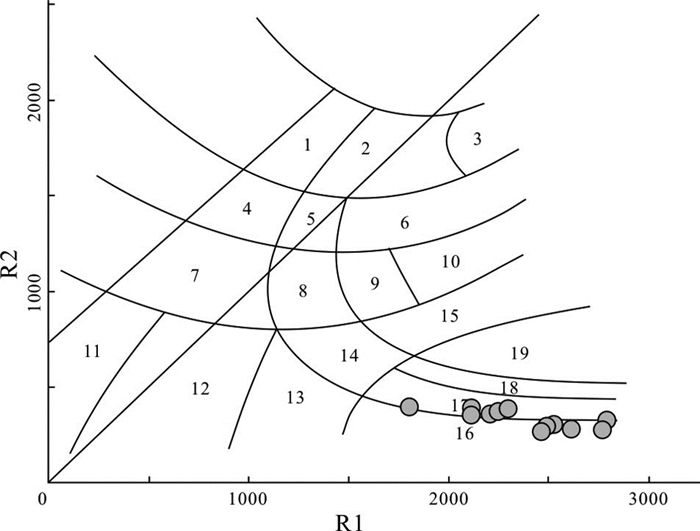
|
图 5 白云常合山A型花岗岩R1-R2分类图解(据De la Roche et al., 1980) 16-碱性花岗岩;17-正长花岗岩 Fig. 5 R1-R2 classification diagram for the A-type granites in the Baiyunchanghe Mountain (after De la Roche et al., 1980) 16-alkali granite; 17-syeno granite |
研究区白云常合花岗岩稀土元素特征显示高REE含量(453×10-6~1093×10-6),(La/Yb)N为8.95~27.4,轻稀土相对富集,(La/Sm)N为3.62~4.98,(Gd/Yb)N为1.70~3.79,轻、重稀土分馏明显。球粒陨石标准化稀土配分曲线呈现典型的“海鸥型”样式(图 6a),显示强烈的Eu负异常(δEu=0.07~0.21),表明源区残留相有斜长石,指示源区深度较浅(张旗等,2008)。

|
图 6 白云常合山A型花岗岩球粒陨石标准化REE配分模式图(a)及原始地幔标准化微量元素蛛网图(b)(标准化值据Sun and McDonough, 1989) Fig. 6 Chondrite-normalized REE pattern (a) and primary mantle-normalized trace element spider pattern (b) of A-type granites in the Baiyunchanghe Mountain (normalization values from Sun and McDonough, 1989) |
微量元素普遍具有以下特点:Rb(41×10-6~147×10-6,平均值为103×10-6)、Th(13.3×10-6~31.6×10-6,平均值为25.2×10-6)、Ga(24.5×10-6~38.2×10-6,平均值为29.8×10-6)、Nb(46.2×10-6~160×10-6,平均值为99.4×10-6)、Zr(252×10-6~863×10-6,平均值为585×10-6)、Y(24.2×10-6~120×10-6,平均值为80.1×10-6)和Yb(2.64×10-6~13.5×10-6,平均值为8.91×10-6)等元素含量较高,Sr(24.0×10-6~133×10-6,平均值为66.2×10-6)、Eu(0.39×10-6~1.67×10-6,平均值为1.10×10-6)等元素含量较低,在原始地幔标准化微量元素配分图上(图 6b)可见大离子亲石元素Rb、Th、K等相对富集,Ba、Sr、Eu、Ti、P则明显亏损。10000×Ga/Al值和Zr+Nb+Ce+Y含量较高,分别为3.63~6.17和576×10-6~1484×10-6。
3 锆石U-Pb年龄及Hf同位素特征测年样品采集新鲜的整块岩石,粉碎至60~80目,用浮选和电磁选进行单矿物分选,在双目镜下对锆石挑纯,然后进行制靶和阴极发光照相。锆石挑选完成之后,制靶、阴极发光照相、U-Pb定年测试分析和Hf同位素分析均在天津地质调查中心实验室完成。参照阴极发光图像对锆石选取合适的分析位置,进行U-Pb定年测试,分析所用的LA-MC-ICP-MS由New Wave的193 nm激光剥蚀系统和Thermo Fisher的Neptune多接收等离子体质谱仪组成(肖志斌等, 2013, 2017)。本次分析的激光剥蚀斑径为35μm,频率为8Hz,能量为5mJ。分析时采用锆石GJ-1作为年龄外标,NIST610作为元素含量外标。完成定年测试之后,使用同一仪器,在相同锆石上进行Hf同位素分析,激光剥蚀斑径为50μm,锆石GJ-1和91500作为数据监控样品。
A型花岗岩测年样品(13NM22-1)采自东五分子村南3km处(碱长花岗岩,坐标:41°01′54″N、109°35′58″E)。选择测年的锆石呈自形-半自形长柱状或板状,粒径100~200μm,阴极发光图像(图 7)显示所有的锆石都具有规则生长的振荡环带,同时从测试数据可知,锆石的Th/U值为0.44~1.71,均大于0.1 (表 2),为典型的岩浆锆石的特征。部分锆石表面可见溶蚀凹坑和裂纹,还有少量锆石中间存在先存锆石核心,可能为岩浆上升过程中捕掳的锆石,但粒径非常小,与成岩过程中形成的锆石有明显的区别。

|
图 7 白云常合山A型花岗岩代表性锆石阴极发光图像 Fig. 7 Typical zircon cathodoluminescence (CL) images of the A-type granites in the Baiyunchanghe Mountain |
|
|
表 2 固阳地区白云常合山A型花岗岩(样品13NM22-1)锆石U-Pb定年结果 Table 2 Zircon dating results of the A-type granite (Sample 13NM22-1) in the Baiyunchanghe Mountain, Guyang area |
依据CL图像,选择自形程度较好、环带清晰的32颗锆石进行LA-MC-ICP-MS U-Pb同位素测试。测点中13NM22-1.19因信号太低,没有采集到数据被剔除,另有6个点因谐和度太低,且离群,因此在作图时没有采用。剩余25个点构成不一致线和谐和线的交点年龄为1720±11Ma(MSWD=1.9, n=25)(图 8),加权平均年龄为1720±12Ma(MSWD=1.7, n=25),二者是一致的,可以代表A型花岗岩的结晶年龄,即白云常合山A型花岗岩的成岩年龄为~1720Ma。
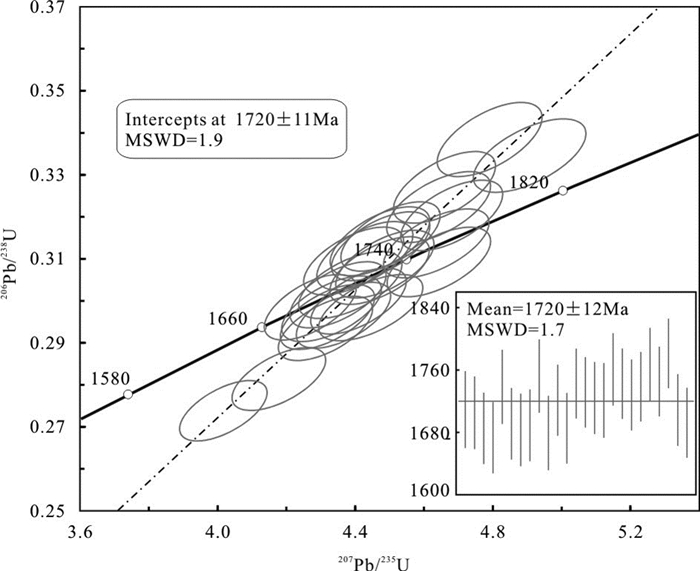
|
图 8 白云常合山A型花岗岩的锆石U-Pb年龄谐和图 Fig. 8 U-Pb concordia diagram of zircons from the A-type granites in the Baiyunchanghe Mountain |
在锆石U-Pb测年的基础上,对部分颗粒形态较好、环带清晰且已获得年龄数据的锆石进行微区原位Hf同位素测试。测试结果见表 3。锆石176Hf/177Hf变化范围较小(0.281676~0.281901),表明Hf同位素分布均一,来自单一源区,εHf(t)=-1.84~+6.08,以正值为主。单阶段模式年龄为1.9~2.2Ga,平均值为2.1Ga;二阶段模式年龄(tHf2)为2.5~3.2Ga,平均值2.76Ga。在εHf(t)-t图解上(图 9),白云常合山花岗岩的测点大都落在2.5~2.2Ga地壳演化线的区域内。
|
|
表 3 固阳地区白云常合山A型花岗岩(样品13NM22-1)锆石Hf同位素数据 Table 3 Lu-Hf isotopic compositions of the A-type granite (Sample 13NM22-1) in the Baiyunchanghe Mountain, Guyang area |
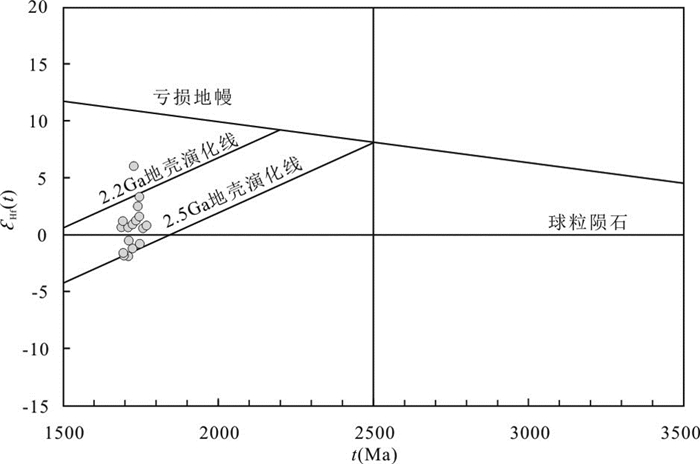
|
图 9 白云常合山A型花岗岩的锆石εHf(t)与年龄相关图(底图据吴福元等,2007) Fig. 9 Plot of εHf(t) vs. ages of zircons from the A-type granites in the Baiyunchanghe Mountain (base map after Wu et al., 2007) |
花岗岩因不同的分类依据有多种分类方法,其中最广泛使用的是S-I-M-A型分类法。但对S-I-M-A的分类标志意见并不一致:I、M、S型依据源区不同而分开,I型的源岩主要为基性岩,S型来自沉积岩,M型来自幔源,而A型花岗岩的分类依据则是伸展的构造背景(张旗和李承东, 2012)。白云常合山花岗岩主要矿物为钾长石、斜长石和石英,部分样品含有黑云母和磁铁矿,未出现富铝硅酸盐岩矿物,且K2O/Na2O值较高,A/CNK < 1.1,同时,区域上未出现与其相伴生的岛弧火山岩,由此可以判定其不属于M型和S型花岗岩。A型花岗岩和高分异I型花岗岩在化学成分上极其相似,其根本的区别在于A型花岗岩更富铁而贫镁(Whalen et al., 1987;Frost et al., 2001),白云常合山花岗岩Fe2O3T/MgO值为12.60~90.38,远高于高分异I型花岗岩(~2.27)和S型花岗岩(~2.38)(Whalen et al., 1987;Frost et al., 2001)。典型的A型花岗岩富Si、Na和K,贫Ca、Mg、和Al,Ga/Al(10000×Ga/Al>2.6)值高,微量元素富集Rb、Th、Nb、Ta、Zr、Hf、Ga、Y,亏损Sr、Ti、P、Ba、Cr、Co、Ni、V等,稀土元素配分曲线常呈海鸥式分布,具有明显的Eu负异常(Collins et al., 1982;Whalen et al., 1987)。研究区花岗岩SiO2含量为70.68%~77.21%,平均值为73.99%,(Na2O+K2O)含量为7.88%~9.21%,且大部分样品的K2O含量都高于Na2O含量,Al2O3、MgO、CaO含量均较低,分别为11.70%~13.23%、0.06%~0.24%、0.23%~1.20%,10000×Ga/Al值为3.63~6.17。球粒陨石标准化稀土元素配分模式显示强烈的Eu负异常(δEu=0.07~0.21),轻稀土相对富集,重稀土亏损,呈现典型的“海鸥型”样式(图 6a)。微量元素普遍具有以下特点:Rb、Th、Ga、Nb、Zr、Y和Yb等元素含量较高,Sr、Eu等元素含量较低,在原始地幔标准化微量元素图解上(图 6b)可见大离子亲石元素Rb、Th、K等相对富集,Ba、Sr、Eu、Ti、P则明显亏损,与张旗等(2006, 与2010)定义的南岭型花岗岩相似。Zr+Nb+Ce+Y含量为576×10-6~1484×10-6含量大于A型花岗岩的下限值(350×10-6),在对应图解上也都落在A型花岗岩的区域内(图 10)。另外A型花岗岩具有较高的锆石饱和温度,依据的锆石饱和温度公式(Watson et al., 2006),计算得到白云常合山花岗岩的结晶温度为824~957℃,平均值为903℃。因此,根据白云常合山花岗岩的矿物组合、地球化学和结晶温度等特征,判定其属于A型花岗岩。

|
图 10 白云常合山A型花岗岩判别图(据Whalen et al., 1987) Fig. 10 The discrimination diagrams for the A-type granites in the Baiyunchanghe Mountain (after Whalen et al., 1987) |
目前,对于A型花岗岩的成因模式主流的观点有:(1)幔源岩浆的分异或低程度部分熔融(Eby, 1990, 1992;Frost and Ronald Frost, 1997;Frost et al., 1999);(2)幔源岩浆与地壳物质的相互作用(Dickin, 1994; Litvinovsky et al., 2000, 2002; 邱检生等, 2000; 刘昌实等, 2003; Yang et al., 2006);(3)下地壳岩石的部分熔融(Whalen et al., 1987;Creaser et al., 1991;Frost and Ronald Frost, 1997;张旗等, 2012)。众所周知,地幔物质部分熔融不能直接产生花岗质岩浆,只能产生镁铁质及中性岩浆,再继续演化才能形成花岗质岩浆。研究区未发现与A型花岗岩相伴生的基性或中性侵入岩类,也未见基性包体或岩浆混合的现象。因此,白云常合山A型花岗岩应该不是来自幔源或壳幔物质混合的产物。在(La/Yb)N-δEu图解(图 11)中,所有样品都落在壳源的区域内,表明白云常合山A型花岗岩属于壳源花岗岩类。张旗等(2012)认为A型花岗岩的形成与源岩无关,只与压力有关,而A型花岗岩无水和高温的特征限制其形成部位只能是下地壳。由此可见,白云常合山A型花岗岩应该来源于下地壳物质的部分熔融。锆石εHf(t)以正值为主,偶有绝对值较小的负值,单阶段模式年龄为1.9~2.2Ga,平均值为2.1Ga;二阶段模式年龄(tHf2)为2.5~3.2Ga,平均值2.76Ga;在εHf(t)-t图解上(图 9),白云常合山花岗岩的测点大都落在2.5~2.2Ga地壳演化线的区域内。同时,在测年时挑选出的锆石中存在捕掳的锆石。故岩浆源区主要是新太古代新生地壳,在上升过程中可能受到古老地壳物质的混染,地幔物质只提供热量,并未参与岩浆的形成。因此,白云常合山A型花岗岩可能是地壳减薄背景下,软流圈地幔上涌导致下地壳部分熔融的产物。
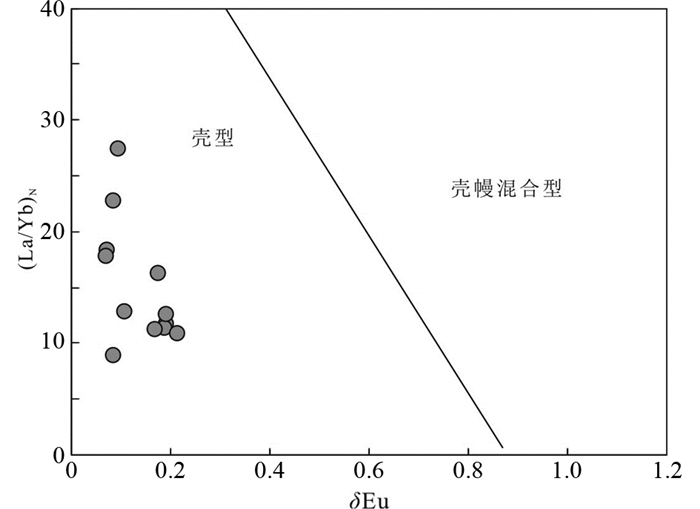
|
图 11 白云常合山A型花岗岩(La/Yb)N-δEu图解(转王玉玺等,2017) Fig. 11 Diagram of (La/Yb)N vs. δEu for the A-type granites in the Baiyunchanghe Mountain (after Wang et al., 2017) |
A型花岗岩因其特殊的形成背景而受到广泛关注,通常形成于地壳减薄的环境,推测地壳的厚度一般不超过30km(张旗等, 2008)。Eby(1990, 1992)根据构造环境的不同将A型花岗岩分成A1型和A2型两个亚类,认为A1型侵位于大陆裂谷或者板内的非造山环境,A2型则主要形成于碰撞后的拉张环境。在Nb-Y-Ce和Nb-Y-3×Ga图解上(图 12),白云常合山花岗岩的样品基本都落在A1型及其过渡区域附近;同时,在Rb/10-Hf-3×Ta和Rb-(Y+Nb)图解上(图 13),研究区样品均落在板内花岗岩的区域内,表明白云常合山A型花岗岩形成于相对稳定的板内环境。
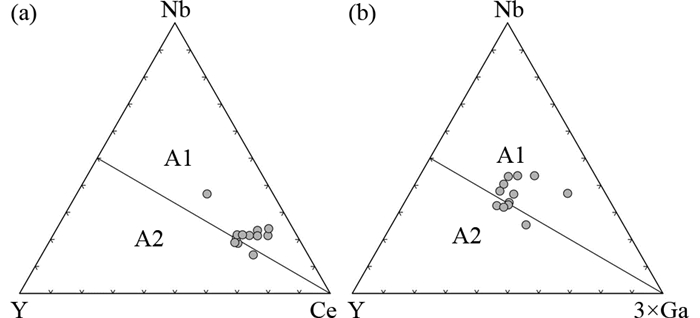
|
图 12 白云常合山A型花岗岩Nb-Y-Ce (a)和Nb-Y-3×Ga (b)图解(据Eby, 1990) Fig. 12 The Nb-Y-Ce (a) and Nb-Y-3×Ga (b) diagrams for the A-type granites in the Baiyunchanghe Mountain (after Eby, 1990) |
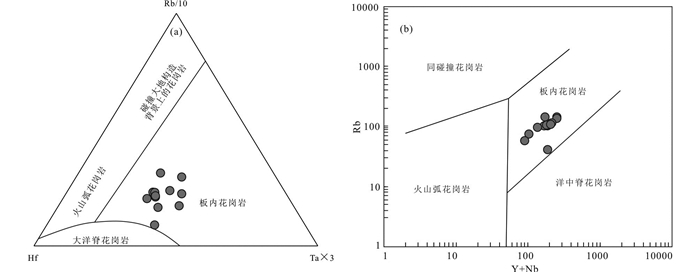
|
图 13 白云常合山A型花岗岩Rb/10-Hf-3×Ta(a, 据Harris et al., 1986)和Rb-(Y+Nb)图解(b, 据Pearce et al., 1984) Fig. 13 The Rb/10-Hf-3×Ta (a, after Harris et al., 1986) and Rb vs. (Y+Nb) (b, after Pearce et al., 1984) diagrams for the A-type granites in the Baiyunchanghe Mountain |
在华北克拉通,广泛发育与Columbia超大陆相关的俯冲、拼合和裂解的地质记录。Zhao et al.(2002a)首次将华北克拉通纳入Columbia超大陆重建方案中,提出2.1~1.8Ga全球规模的造山事件使得Columbia超大陆聚合形成。Columbia超大陆的最初裂解被认为始于1.6Ga(Ernst et al., 2008),但在华北克拉通,裂解事件起始于~1.78Ga(Zhao et al., 2002b, 2004),以华北克拉通南缘的熊耳群(Zhao et al., 2002b)和广泛分布的基性岩墙群为标志(Peng et al., 2008, 2012;侯贵廷等, 2009),甚至更早至~1.85Ga(Hou et al., 2008)。总体来说,华北克拉通的伸展裂解主要集中于古元古代晚期-中元古代,1.8~1.6Ga的裂解事件记录在华北克拉通南缘和北缘广泛分布,其中基性岩墙群和非造山岩浆岩带是指示裂解事件的重要标志。
基性岩墙群主要包括~1.78Ga的太行-吕梁地区岩墙群(Peng, 2010; Peng et al., 2015)和稍晚一些的1.76~1.73Ga密云-北台岩墙群(翟明国等, 2014)。岩墙岩石组合为辉绿岩和辉长辉绿岩,主要呈NNW走向产出,少部分为EW、NE走向,不同走向的岩墙群围绕豫陕裂陷槽呈放射状的形态产出(Peng et al., 2006),岩石学和地球化学特征显示岩墙群基本都属于板内玄武岩系列,具有大陆裂谷玄武岩的特征(侯贵廷, 2012),被认为是与地幔柱相关的大火成岩省的产物(彭澎等, 2004;侯贵廷, 2012;Peng et al., 2012)。
华北克拉通北缘中段广泛发育AMCG组合,形成于1.72~1.67Ga(杨进辉等, 2005;Zhang et al., 2007;高维等, 2008;Zhao et al., 2009b;Jiang et al., 2011),如怀柔北部的兰营石英正长岩(~1697Ma,郁建华等, 1996;1712~1753Ma,Zhang et al., 2007)、密云环斑花岗岩(~1681Ma,高维等, 2008;杨进辉等, 2005)、温泉花岗岩(~1697Ma,Jiang et al., 2011)、内蒙古固阳地区瓦窑石英正长岩(1702Ma,王惠初等, 2012)、涝洼石英二长岩(~1695Ma,相振群, 2014)、建平杂岩体(1699~1712Ma,相振群, 2014),再结合本文的白云常合山A型花岗岩,可能表明华北陆块的AMCG组合向西延伸至固阳一带,形成一条规模宏大的大陆裂解非造山岩浆岩带(王惠初等, 2012)。华北克拉通南缘未形成AMCG岩浆岩带,但也发育了稍晚的A型花岗岩等代表裂解事件的岩石,最典型的是龙王A型花岗岩(1602~1625Ma,陆松年等, 2003;包志伟等, 2009;Wang et al., 2013b),还有麻坪A型花岗岩(1600~1616Ma,邓小芹等, 2015)。
华北克拉通上三大裂陷槽(豫陕裂陷槽、渣尔泰-白云鄂博裂陷槽、燕辽裂陷槽)在中元古代早期相继打开(陆松年和李惠民, 1991;赵太平等, 2004;Lu et al., 2008)。南部的豫陕裂陷槽形成了覆盖于变质基底上1.80~1.75Ga的熊耳群火山岩(Zhao et al., 2001;赵太平等, 2004)以及其后的沉积地层(洛峪口组~1611Ma,苏文博等, 2012)。中部的燕辽裂陷槽的裂解略显滞后,一直到1670Ma后才出现常州沟组的碎屑沉积(李怀坤等, 2011),之后陆续发育大套的碳酸盐岩、白云岩和石英砂岩,局部夹火山岩,团山子组火山岩成岩年龄~1637Ma (张拴宏等, 2013),大红峪组火山岩的成岩年龄为1622~1625Ma(陆松年和李惠民, 1991;Lu et al., 2008)。
阴山地区的渣尔泰-白云鄂博裂陷槽呈东西向展布,南部产出渣尔泰群,北部为白云鄂博群和化德群,均产于早前寒武纪变质基底之上,厚度近8000m,以沉积岩占主导位置,虽然其中也产出一些火山岩,但未得到准确的年龄来限定沉积物的沉积时限。Li et al.(2007)获得渣尔泰群底部火山岩的锆石U-Pb年龄为1743Ma,但因仅有一颗锆石显示该年龄,因此数据上的证据稍显薄弱。Lu et al. (2002)在白云鄂博群下部层位的玄武岩样品中,获得单颗粒锆石U-Pb年龄为~1728Ma,以此为依据初步推断1.8Ga为该群的底部年龄。胡波等(2009)通过对化德群中的变质砂岩碎屑锆石的研究显示,其主峰为1.86Ga和1.72Ga、次峰2.50Ga,最小年龄1646Ma,而Liu et al. (2014)在该群石英砂岩中则得到了最小年龄为1337Ma的结果,表明该群沉积下限要比1337Ma更新。虽然前人在这套沉积物中做了大量的年代学工作,但至今未能有确切的数据来限定其沉积底界,各组碎屑锆石的最小年龄值基本都小于1720Ma(胡波等, 2009;彭润民等, 2010;刘超辉和刘福来, 2015)。白云常合山A型花岗岩形成于~1720Ma,对应于Columbia超大陆的裂解时期,虽然在野外调查中见到白云常合山A型花岗岩与渣尔泰群呈断层接触关系,无法依据该年龄直接确定渣尔泰群的沉积下限,但是可以肯定的是白云常合山A型花岗岩是阴山地区与Columbia超大陆的裂解相关的最早的有精确结晶年龄的岩石记录,而在阴山地区还未见代表更早裂解时间的非造山岩浆的报道。因此,白云常合山A型花岗岩可能代表Columbia超大陆在阴山地区的最初裂解产物。
5 结论本文通过对内蒙古固阳东五分子地区白云常合山花岗岩的岩石学、地球化学、锆石U-Pb年代学和Hf同位素综合研究,并结合区域地质资料,得到以下几点认识:
(1) 白云常合山花岗岩具有高硅,富碱,高Fe2O3T/MgO和Ga/Al值,低Al2O3、MgO、CaO的特征;微量元素富集Rb、Th、K等,亏损Ba、Sr、Eu、Ti、P等;稀土元素配分曲线呈海鸥式分布,具有明显的Eu负异常;结晶温度为824~957℃,平均值为903℃;属于A型花岗岩。
(2) 锆石年代学结果显示,白云常合山花岗岩形成于~1720Ma,与Columbia超大陆裂解的时间相一致。锆石εHf(t)以正值为主,表明岩浆源区主要是新太古代新生地壳,在上升过程中可能受到古老地壳物质的混染。
(3) 地球化学特征和构造环境图解显示白云常合山花岗岩为A1型花岗岩,且有板内岩浆的特点,结合区域地质资料和前人的工作成果,初步推测白云常合山花岗岩应该是阴山地区最早响应Columbia超大陆裂解的岩石记录。
致谢 实验测试过程中得到天津地质调查中心实验测试室的大力支持,在此深表谢意!感谢两位评审专家提出的宝贵意见,受益匪浅。
谨以此文祝贺杨振升先生九十华诞!
Bao ZW, Wang Q, Zi F, Tang GJ, Du FJ and Bai GD. 2009. Geochemistry of the Paleoproterozoic Longwangzhuang A-type granites on the southern margin of North China Craton:Petrogenesis and tectonic implications. Geochimica, 38(6): 509-522 (in Chinese with English abstract) |
Collins WJ, Beams SD, White AJR and Chappell BW. 1982. Nature and origin of A-type granites with particular reference to southeastern Australia. Contributions to Mineralogy and Petrology, 80(2): 189-200 DOI:10.1007/BF00374895 |
Condie KC. 2002. Breakup of a Paleoproterozoic supercontinent. Gondwana Research, 5(1): 41-43 DOI:10.1016/S1342-937X(05)70886-8 |
Creaser RA, Price RC and Wormald RJ. 1991. A-type granites revisited:Assessment of a residual-source model. Geology, 19(2): 163-166 DOI:10.1130/0091-7613(1991)019<0163:ATGRAO>2.3.CO;2 |
De la Roche H, Leterrier J, Grandclaude P and Marchal M. 1980. A classification of volcanic and plutonic rocks using R1R2-diagram and major-element analyses:Its relationships with current nomenclature. Chemical Geology, 29(1-4): 183-210 DOI:10.1016/0009-2541(80)90020-0 |
Deng XQ, Zhao TP, Peng TP, Gao XY and Bao ZW. 2015. Petrogenesis of 1600Ma Maping A-type granite in the southern margin of the North China Craton and its tectonic implications. Acta Petrologica Sinica, 31(6): 1621-1635 (in Chinese with English abstract) |
Dickin AP. 1994. Nd isotope chemistry of Tertiary igneous rocks from Arran, Scotland:Implications for magma evolution and crustal structure. Geological Magazine, 131(3): 329-333 DOI:10.1017/S0016756800011092 |
Eby GN. 1990. The A-type granitoids:A review of their occurrence and chemical characteristics and speculations on their petrogenesis. Lithos, 26(1-2): 115-134 DOI:10.1016/0024-4937(90)90043-Z |
Eby GN. 1992. Chemical subdivision of the A-type granitoids:Petrogenetic and tectonic implications. Geology, 20(7): 641-644 DOI:10.1130/0091-7613(1992)020<0641:CSOTAT>2.3.CO;2 |
Ernst RE, Wingate MTD, Buchan KL and Li ZX. 2008. Global record of 1600~700Ma Large Igneous Provinces (LIPs):Implications for the reconstruction of the proposed Nuna (Columbia) and Rodinia supercontinents. Precambrian Research, 160(1-2): 159-178 DOI:10.1016/j.precamres.2007.04.019 |
Frost BR, Barnes CG, Collins WJ, Arculus RJ, Ellis DJ and Frost CD. 2001. A geochemical classification for granitic rocks. Journal of Petrology, 42(11): 2033-2048 DOI:10.1093/petrology/42.11.2033 |
Frost CD and Ronald Frost B. 1997. Reduced rapakivi-type granites:The tholeiite connection. Geology, 25(7): 647-650 DOI:10.1130/0091-7613(1997)025<0647:RRTGTT>2.3.CO;2 |
Frost CD, Bell JM, Frost BR, Chamberlain KR and Anonymous. 1999. Tholeiitic source for A-type granites:Evidence from the northern Sherman Batholith, Southeast Wyoming, U.S.A. Abstracts with Programs:Geological Society of America, 31(7): 261 |
Frost CD, Rämö OT and Dall'Agnol R. 2007. IGCP Project 510:A-type granites and related rocks through Time. Lithos, 97(1-2): vii-xiii DOI:10.1016/j.lithos.2007.01.006 |
Gao W, Zhang CH, Gao LZ, Shi XY, Liu YM and Song B. 2008. Zircon SHRIMP U-Pb age of rapakivi granite in Miyun, Beijing, China, and its tectono-stratigraphic implications. Geological Bulletin of China, 27(6): 793-798 (in Chinese with English abstract) |
Geng YS, Kuang HW, Du LL, Liu YQ and Zhao TP. 2019. On the Paleo-Mesoproterozoic boundary from the breakup event of the Columbia supercontinent. Acta Petrologica Sinica, 35(8): 2299-2324 (in Chinese with English abstract) DOI:10.18654/1000-0569/2019.08.02 |
Gradstein FM, Ogg JG, Smith AG, Bleeker W and Lourens LJ. 2004. A new Geologic Time Scale, with special reference to Precambrian and Neogene. Episodes, 27(2): 83-100 DOI:10.18814/epiiugs/2004/v27i2/002 |
Harris NBW, Pearce JA and Tindle AG. 1986. Geochemical characteristics of collision-zone magmatism. Geological Society, London, Special Publications, 19(1): 67-81 DOI:10.1144/GSL.SP.1986.019.01.04 |
He YH, Zhao GC, Sun M and Xia XP. 2009. SHRIMP and LA-ICP-MS zircon geochronology of the Xiong'er volcanic rocks:Implications for the Paleo-Mesoproterozoic evolution of the southern margin of the North China Craton. Precambrian Research, 168(3-4): 213-222 DOI:10.1016/j.precamres.2008.09.011 |
Hou GT, Santosh M, Qian XL, Lister GS and Li JH. 2008. Configuration of the Late Paleoproterozoic supercontinent Columbia:Insights from radiating mafic dyke swarms. Gondwana Research, 14(3): 395-409 DOI:10.1016/j.gr.2008.01.010 |
Hou GT, Halls H, Davis D, Huang BL, Yang MH and Wang CC. 2009. Paleomagnetic poles of mafic dyke swarms from the North China Craton and their relevance to the reconstruction of the supercontinent Columbia. Acta Petrologica Sinica, 25(3): 650-658 (in Chinese with English abstract) |
Hou GT. 2012. Mafic Dyke Swarms of North China. Beijing: Science Press, 1-177 (in Chinese with English abstract)
|
Hu B, Zhai MG, Guo JH, Peng P, Liu F and Liu S. 2009. LA-ICP-MS U-Pb geochronology of detrital zircons from the Huade Group in the northern margin of the North China Craton and its tectonic significance. Acta Petrologica Sinica, 25(1): 193-211 (in Chinese with English abstract) |
Jia XH, Wang Q and Tang GJ. 2009. A-type granites:Research progress and implications. Geotectonica et Metallogenia, 33(3): 465-480 (in Chinese with English abstract) |
Jian P, Zhang Q, Liu DY, Jin WJ, Jia XQ and Qian Q. 2005. SHRIMP dating and geological significance of Late Achaean high-Mg diorite (sanukite) and hornblende-granite at Guyang of Inner Mongolia. Acta Petrologica Sinica, 21(1): 151-157 (in Chinese with English abstract) |
Jiang N, Guo JH and Zhai MG. 2011. Nature and origin of the Wenquan granite:Implications for the provenance of Proterozoic A-type granites in the North China Craton. Journal of Asian Earth Sciences, 42(1-2): 76-82 DOI:10.1016/j.jseaes.2011.04.010 |
Li HK, Su WB, Zhou HY, Geng JZ, Xiang ZQ, Cui YR, Liu WC and Lu SN. 2011. The base age of the Changchengian System at the northern North China Craton should be younger than 1670Ma:Constraints from zircon U-Pb LA-MC-ICPMS dating of a granite-porphyry dike in Miyun County, Beijing. Earth Science Frontiers, 18(3): 108-120 (in Chinese with English abstract) |
Li JH, Niu XL, Kusky T and Polat A. 2004. Neoarchean plate tectonic evolution of North China and its correlation with global cratonic blocks. Earth Science Frontiers, 11(3): 273-283 (in Chinese with English abstract) |
Li QL, Chen FK, Guo JH, Li XH, Yang YH and Siebel W. 2007. Zircon ages and Nd-Hf isotopic composition of the Zhaertai Group (Inner Mongolia):Evidence for Early Proterozoic evolution of the northern North China Craton. Journal of Asian Earth Sciences, 30(3-4): 573-590 DOI:10.1016/j.jseaes.2007.01.006 |
Litvinovsky BA, Steele IM and Wickham SM. 2000. Silicic magma formation in overthickened crust:Melting of charnockite and leucogranite at 15, 20 and 25kbar. Journal of Petrology, 41(5): 717-737 DOI:10.1093/petrology/41.5.717 |
Litvinovsky BA, Jahn BM, Zanvilevich AN, Saunders A, Poulain S, Kuzmin DV, Reichow MK and Titov AV. 2002. Petrogenesis of syenite-granite suites from the Bryansky Complex (Transbaikalia, Russia):Implications for the origin of A-type granitoid magmas. Chemical Geology, 189(1-2): 105-133 DOI:10.1016/S0009-2541(02)00142-0 |
Liu CH, Zhao GC and Liu FL. 2014. Detrital zircon U-Pb, Hf isotopes, detrital rutile and whole-rock geochemistry of the Huade Group on the northern margin of the North China Craton:Implications on the breakup of the Columbia supercontinent. Precambrian Research, 254: 290-305 DOI:10.1016/j.precamres.2014.09.011 |
Liu CH and Liu FL. 2015. The Mesoproterozoic rifting in the North China Craton:A case study for magmatism and sedimentation of the Zhaertai-Bayan Obo-Huade rift zone. Acta Petrologica Sinica, 31(10): 3107-3128 (in Chinese with English abstract) |
Liu CS, Chen XM, Wang RC and Hu H. 2003. Origin of Nankunshan aluminous A-type granite, Longkou County, Guangdong Province. Acta Petrologica et Mineralogica, 22(1): 1-10 (in Chinese with English abstract) |
Liu SW, Santosh M, Wang W, Bai X and Yang PT. 2011. Zircon U-Pb chronology of the Jianping Complex:Implications for the Precambrian crustal evolution history of the northern margin of North China Craton. Gondwana Research, 20(1): 48-63 DOI:10.1016/j.gr.2011.01.003 |
Lu SN and Li HM. 1991. A precise U-Pb single zircon age determination for the volcanics of Dahongyu Formation, Changcheng System in Jixian. Bulletin of the Chinese Academy of Geological Sciences, 22(01): 137-146 (in Chinese with English abstract) |
Lu SN, Yang CL, Li HK and Li HM. 2002. A group of rifting events in the terminal Paleoproterozoic in the North China Craton. Gondwana Research, 5(1): 123-131 DOI:10.1016/S1342-937X(05)70896-0 |
Lu SN, Yang CL, Li HK and Chen ZH. 2002. North China continent and Columbia supercontinent. Earth Science Frontiers, 9(4): 225-233 (in Chinese with English abstract) |
Lu SN, Li HK, Li HM, Song B, Wang SY, Zhou HY and Chen ZH. 2003. U-Pb isotopic ages and their significance of alkaline granite in the southern margin of the North China Craton. Geological Bulletin of China, 22(10): 762-768 (in Chinese with English abstract) |
Lu SN, Zhao GC, Wang HC and Hao GJ. 2008. Precambrian metamorphic basement and sedimentary cover of the North China Craton:A review. Precambrian Research, 160(1-2): 77-93 DOI:10.1016/j.precamres.2007.04.017 |
National Commission of Stratigraphy. 1981. Stratigraphical Guide of China and Its Explanation. Beijing: Geological Publishing House, 1-59 (in Chinese)
|
National Commission of Stratigraphy. 2002. Regional Chronostratigraphic Chart of China (Geologic Time). Beijing: Geological Publishing House, 1-72 (in Chinese)
|
Pearce JA, Harris NBW and Tindle AG. 1984. Trace element discrimination diagrams for the tectonic interpretation of granitic rocks. Journal of Petrology, 25(4): 956-983 DOI:10.1093/petrology/25.4.956 |
Peng P, Zhai MG, Zhang HF, Zhao TP and Ni ZY. 2004. Geochemistry and geological significance of the 1.8Ga mafic dyke swarms in the North China Craton:An example from the juncture of Shanxi, Hebei and Inner Mongolia. Acta Petrologica Sinica, 20(3): 439-456 (in Chinese with English abstract) |
Peng P, Zhai MG and Guo JH. 2006. 1.80~1.75Ga mafic dyke swarms in the central North China Craton: Implications for a plume-related break-up event. In: Hanski E, Mertanen S, Rämö T and Vuollo J (eds.). Dyke Swarms: Time Markers of Crustal Evolution. London: Taylor & Francis, 99-112
|
Peng P, Zhai MG, Guo JH, Kusky T and Zhao TP. 2007. Nature of mantle source contributions and crystal differentiation in the petrogenesis of the 1.78Ga mafic dykes in the central North China Craton. Gondwana Research, 12(1-2): 29-46 DOI:10.1016/j.gr.2006.10.022 |
Peng P, Zhai MG, Ernst RE, Guo JH, Liu F and Hu B. 2008. A 1.78Ga large igneous province in the North China Craton:The Xiong'er volcanic province and the North China dyke swarm. Lithos, 101(3-4): 260-280 DOI:10.1016/j.lithos.2007.07.006 |
Peng P. 2010. Reconstruction and interpretation of giant mafic dyke swarms:A case study of 1.78Ga magmatism in the North China Craton. Geological Society, London, Special Publications, 338(1): 163-178 DOI:10.1144/SP338.8 |
Peng P, Liu F, Zhai MG and Guo JH. 2012. Age of the Miyun dyke swarm:Constraints on the maximum depositional age of the Changcheng System. Chinese Science Bulletin, 57(1): 105-110 DOI:10.1007/s11434-011-4771-x |
Peng P, Wang XP, Lai Y, Wang C and Windley BF. 2015. Large-scale liquid immiscibility and fractional crystallization in the 1780Ma Taihang dyke swarm:Implications for genesis of the bimodal Xiong'er volcanic province. Lithos, 236-237: 106-122 DOI:10.1016/j.lithos.2015.08.015 |
Peng RM, Zhai YS, Wang JP, Chen XF, Liu Q, Lü JY, Shi YX, Wang G, Li SB, Wang LG, Ma YT and Zhang P. 2010. Discovery of Neoproterozoic acid volcanic rock in the south-western section of Langshan, Inner Mongolia. Chinese Science Bulletin, 55(26): 2611-2620 (in Chinese) DOI:10.1360/972010-266 |
Qiu JS, Kanisawa S and Wang DZ. 2000. Geochemical characteristics and genetic type of Yaokeng alkali granites in Cangnan County, Zhejiang Province. Acta Petrologica et Mineralogica, 19(2): 97-105 (in Chinese with English abstract) |
Rogers JJW and Santosh M. 2002. Mesoproterozoic supercontinent:Introduction. Gondwana Research, 5(1): 3-4 DOI:10.1016/S1342-937X(05)70882-0 |
Rollinson HR. 1993. Using Geochemical Data: Evaluation, Presentation, Interpretation. London: Taylor & Francis Group, 1-384
|
Shand SJ. 1950. Eruptive Rocks Their Genesis, Composition, Classification and Their Relation to Ore Deposit. 4th Edition. Murby, London: 1-488
|
Su WB, Li HK, Xu L, Jia SH, Geng JZ, Zhou HY, Wang ZH and Pu HY. 2012. Luoyu and Ruyang groups at the south margin of the North China Craton (NCC) should belong to the Mesoproterozoic Changchengian System:Direct constraints from the LA-MC-ICPMS U-Pb age of the tuffite in the Luoyukou Formation, Ruzhou, Henan, China. Geological Survey and Research, 35(2): 96-108 (in Chinese with English abstract) |
Su WB. 2014. A review of the revised Precambrian Time Scale (GTS2012) and the research of the Mesoproterozoic chronostratigraphy of China. Earth Science Frontiers, 21(2): 119-138 (in Chinese with English abstract) |
Sun SS and McDonough WF. 1989. Chemical and isotopic systematics of oceanic basalts: Implications for mantle composition and processes. In: Saunders AD and Norry MJ (eds.). Magmatism in the Ocean Basins. Geological Society, London, Special Publications, 42(1): 313-345
|
Tapani Rämö O, Haapala I, Vaasjoki M, Yu JH and Fu HQ. 1995. 1700Ma Shachang complex, Northeast China:Proterozoic rapakivi granite not associated with Paleoproterozoic orogenic crust. Geology, 23(9): 815-818 DOI:10.1130/0091-7613(1995)023<0815:MSCNCP>2.3.CO;2 |
Wang HC, Yuan GB, Xin HT and Wang JL. 1999. On the tectonic implication for Xiashihao-Jiuguan ductile shear zone in Guyang-Wuchuan area, Inner Mongolia. Progress in Precambrian Research, 22(1): 12-20 (in Chinese with English abstract) |
Wang HC, Xiang ZQ, Zhao FQ, Li HM, Yuan GB and Chu H. 2012. The alkaline plutons in eastern part of Guyang County, Inner Mongolia:Geochronology, petrogenesis and tectonic implications. Acta Petrologica Sinica, 28(9): 2843-2854 (in Chinese with English abstract) |
Wang W, Liu SW, Bai X, Li QG, Yang PT, Zhao Y, Zhang SH and Guo RR. 2013a. Geochemistry and zircon U-Pb-Hf isotopes of the Late Paleoproterozoic Jianping diorite-monzonite-syenite suite of the North China Craton:Implications for petrogenesis and geodynamic setting. Lithos, 162-163: 175-194 DOI:10.1016/j.lithos.2013.01.005 |
Wang XL, Jiang SY, Dai BZ and Kern J. 2013b. Lithospheric thinning and reworking of Late Archean juvenile crust on the southern margin of the North China Craton:Evidence from the Longwangzhuang Paleoproterozoic A-type granites and their surrounding Cretaceous adakite-like granites. Geological Journal, 48(5): 498-515 DOI:10.1002/gj.2464 |
Wang YX, Wang JR, Zhou XL, Wang HT, Di PF, Wang XW and Chen WF. 2017. The cracking of Columbia supercontinent:Evidence from the Dahongshan A-type granite in the southeastern Tarim Craton. Acta Geologica Sinica, 91(11): 2369-2386 (in Chinese with English abstract) |
Watson EB, Wark DA and Thomas JB. 2006. Crystallization thermometers for zircon and rutile. Contributions to Mineralogy and Petrology, 151(4): 413-433 DOI:10.1007/s00410-006-0068-5 |
Whalen JB, Currie KL and Chappell BW. 1987. A-type granites:Geochemical characteristics, discrimination and petrogenesis. Contributions to Mineralogy and Petrology, 95(4): 407-419 DOI:10.1007/BF00402202 |
Wu FY, Li XH, Zheng YF and Gao S. 2007. Lu-Hf isotopic systematics and their applications in petrology. Acta Petrologica Sinica, 23(2): 195-220 (in Chinese with English abstract) |
Xiang ZQ. 2014. Mesoproterozoic magmatic events and mineralization in the North China Craton. Ph. D. Dissertation. Beijing: China University of Geosciences, 1-239 (in Chinese with English summary)
|
Xiao ZB, Kang JL, Wang HC, Gao ZR, Xiang ZQ, Chu H and Ren YW. 2015. Formation age of Alxa Group-complex (Special) in Alxa area, Inner Mongolia. Geological Survey and Research, 38(3): 182-191 (in Chinese with English abstract) |
Xiao ZB, Wang HC, Kang JL, Bao ZA, Sun YW and Liu WG. 2017. U-Pb chronology, Hf isotope and geological implication of zircons from the Neoarchean quartzite in Changyi area, eastern Shandong. Acta Petrologica Sinica, 33(9): 2925-2938 (in Chinese with English abstract) |
Xie GH. 2005. Petrology and Geochemistry of the Damiao Anorthosite and the Miyun Rapakivi Granite. Beijing: Science Press, 1-195 (in Chinese)
|
Xu ZY, Liu ZH, Yang ZS, Wu XW and Chen XF. 2007. Structure of metamorphic strata of the khondalite series in the Daqingshan-Wulashan area, central Inner Mongolia, China, and their geodynamic implications. Geological Bulletin of China, 26(5): 526-536 (in Chinese with English abstract) |
Yang JH, Wu FY, Liu XM and Xie LW. 2005. Zircon U-Pb ages and Hf isotopes and their geological significance of the Miyun rapakivi granites from Beijing, China. Acta Petrologica Sinica, 21(6): 1633-1644 (in Chinese with English abstract) |
Yang JH, Wu FY, Chung SL, Wilde SA and Chu MF. 2006. A hybrid origin for the Qianshan A-type granite, Northeast China:Geochemical and Sr-Nd-Hf isotopic evidence. Lithos, 89(1-2): 89-106 DOI:10.1016/j.lithos.2005.10.002 |
Yu JH, Fu HQ, Haapala I, Ramo OT, Vaasjoki M and Mortensen JK. 1996. A 1.70Ga anorogenic rapakivi granite suite in the northern part of North China Craton. Journal of Geology & Mineral Resources in North China, 11(3): 341-350 (in Chinese with English abstract) |
Zhai MG. 2004. 2.1~1.7Ga geological event group and its geotectonic significance. Acta Petrologica Sinica, 20(6): 1343-1354 (in Chinese with English abstract) |
Zhai MG, Hu B, Peng P and Zhao TP. 2014. Meso-Neoproterozoic magmatic events and multi-stage rifting in the NCC. Earth Science Frontiers, 21(1): 100-119 (in Chinese with English abstract) |
Zhang HT. 1992. Granitoid magma series and gold mineralization in Baotou-Bayan Obo, Inner Mongolia. Ph. D. Dissertation. Beijing: Chinese Academy of Geological Sciences, 1-136 (in Chinese)
|
Zhang Q, Wang Y, Li CD, Wang YL, Jin WJ and Jia XQ. 2006. Granite classification on the basis of Sr and Yb contents and its implications. Acta Petrologica Sinica, 22(9): 2249-2269 (in Chinese with English abstract) |
Zhang Q, Wang Y, Xiong XL and Li CD. 2008. Adakite and Granite:Challenge and Opportunity. Beijing: China Land Press, 1-344 (in Chinese with English abstract)
|
Zhang Q, Jin WJ, Li CD and Wang YL. 2010. Revisiting the new classification of granitic rocks based on whole-rock Sr and Yb contents:Index. Acta Petrologica Sinica, 26(4): 985-1015 (in Chinese with English abstract) |
Zhang Q and Li CD. 2012. Granites:Implications for Continental Geodynamics. Beijing: Ocean Press, 1-276 (in Chinese with English abstract)
|
Zhang Q, Ran H and Li CD. 2012. A-type granite:What is the essence?. Acta Petrologica et Mineralogica, 31(4): 621-626 (in Chinese with English abstract) |
Zhang SH, Liu SW, Zhao Y, Yang JH, Song B and Liu XM. 2007. The 1.75~1.68Ga anorthosite-mangerite-alkali granitoid-rapakivi granite suite from the northern North China Craton:Magmatism related to a Paleoproterozoic orogen. Precambrian Research, 155(3-4): 287-312 DOI:10.1016/j.precamres.2007.02.008 |
Zhang SH, Zhao Y, Ye H, Hu JM and Wu F. 2013. New constraints on ages of the Chuanlinggou and Tuanshanzi formations of the Changcheng System in the Yan-Liao area in the northern North China Craton. Acta Petrologica Sinica, 29(7): 2481-2490 (in Chinese with English abstract) |
Zhao GC, Cawood PA, Wilde SA and Sun M. 2002a. Review of global 2.1~1.8Ga orogens:Implications for a pre-Rodinia supercontinent. Earth-Science Reviews, 59(1-4): 125-162 DOI:10.1016/S0012-8252(02)00073-9 |
Zhao GC, Sun M, Wilde SA and Li SZ. 2004. A Paleo-Mesoproterozoic supercontinent:Assembly, growth and breakup. Earth-Science Reviews, 67(1-2): 91-123 DOI:10.1016/j.earscirev.2004.02.003 |
Zhao GC, Sun M, Simon AW and Li SZ. 2005. Late Archean to Paleoproterozoic evolution of the North China Craton:Key issues revisited. Precambrian Research, 136(2): 177-202 DOI:10.1016/j.precamres.2004.10.002 |
Zhao GC, He YH and Sun M. 2009a. The Xiong'er volcanic belt at the southern margin of the North China Craton:Petrographic and geochemical evidence for its outboard position in the Paleo-Mesoproterozoic Columbia Supercontinent. Gondwana Research, 16(2): 170-181 DOI:10.1016/j.gr.2009.02.004 |
Zhao TP, Zhou MF, Jin CW, Guan H and Li HM. 2001. Discussion on age of the Xiong'er Group in southern margin of North China Craton. Scientia Geologica Sinica, 36(3): 326-334 (in Chinese with English abstract) |
Zhao TP, Zhou MF, Zhai MG and Xia B. 2002b. Paleoproterozoic rift-related volcanism of the Xiong'er Group, North China Craton:Implications for the breakup of Columbia. International Geology Review, 44(4): 336-351 DOI:10.2747/0020-6814.44.4.336 |
Zhao TP, Zhai MG, Xia B, Li HM, Zhang YX and Wan YS. 2004. Zircon U-Pb SHRIMP dating for the volcanic rocks of the Xiong'er Group:Constraints on the initial formation age of the cover of the North China Craton. Chinese Science Bulletin, 49(23): 2495-2502 DOI:10.1007/BF03183721 |
Zhao TP and Zhou MF. 2009. Geochemical constraints on the tectonic setting of Paleoproterozoic A-type granites in the southern margin of the North China Craton. Journal of Asian Earth Sciences, 36(2-3): 183-195 DOI:10.1016/j.jseaes.2009.05.005 |
Zhao TP, Chen W and Zhou MF. 2009b. Geochemical and Nd-Hf isotopic constraints on the origin of the ~1.74Ga Damiao anorthosite complex, North China Craton. Lithos, 113(3-4): 673-690 DOI:10.1016/j.lithos.2009.07.002 |
Zhao TP, Deng XQ, Hu GH, Zhou YY, Peng P and Zhai MG. 2015. The Paleoproterozoic- Mesoproterozoic boundary of the North China Craton and the related geological issues:A review. Acta Petrologica Sinica, 31(6): 1495-1508 (in Chinese with English abstract) |
Zhao TP, Pang LY, Qiu YF, Zhu XY, Wang SY and Geng YS. 2019. The Paleo-Mesoproterozoic boundary:1.8Ga. Acta Petrologica Sinica, 35(8): 2281-2298 (in Chinese with English abstract) DOI:10.18654/1000-0569/2019.08.01 |
包志伟, 王强, 资锋, 唐功建, 杜凤军, 白国典. 2009. 龙王䃥A型花岗岩地球化学特征及其地球动力学意义. 地球化学, 38(6): 509-522. |
邓小芹, 赵太平, 彭头平, 高昕宇, 包志伟. 2015. 华北克拉通南缘1600Ma麻坪A型花岗岩的成因及其地质意义. 岩石学报, 31(6): 1621-1635. |
高维, 张传恒, 高林志, 史晓颖, 刘耀明, 宋彪. 2008. 北京密云环斑花岗岩的锆石SHRIMP U-Pb年龄及其构造意义. 地质通报, 27(6): 793-798. |
耿元生, 旷红伟, 杜利林, 柳永清, 赵太平. 2019. 从哥伦比亚超大陆裂解事件论古/中元古代的界限. 岩石学报, 35(8): 2299-2324. |
侯贵廷, Halls H, Davis D, 黄宝玲, 杨默函, 王传成. 2009. 华北基性岩墙群的古地磁极及其哥伦比亚超大陆重建意义. 岩石学报, 25(3): 650-658. |
侯贵廷. 2012. 华北基性岩墙群. 北京: 科学出版社, 1-177.
|
胡波, 翟明国, 郭敬辉, 彭澎, 刘富, 刘爽. 2009. 华北克拉通北缘化德群中碎屑锆石的LA-ICP-MSU-Pb年龄及其构造意义. 岩石学报, 25(1): 193-211. |
贾小辉, 王强, 唐功建. 2009. A型花岗岩的研究进展及意义. 大地构造与成矿学, 33(3): 465-480. |
简平, 张旗, 刘敦一, 金维浚, 贾秀勤, 钱青. 2005. 内蒙古固阳晚太古代赞岐岩(sanukite)——角闪花岗岩的SHRIMP定年及其意义. 岩石学报, 21(1): 151-157. |
李怀坤, 苏文博, 周红英, 耿建珍, 相振群, 崔玉荣, 刘文灿, 陆松年. 2011. 华北克拉通北部长城系底界年龄小于1670Ma:来自北京密云花岗斑岩岩脉锆石LA-MC-ICPMS U-Pb年龄的约束. 地学前缘, 18(3): 108-120. |
李江海, 牛向龙, Kusky T, Polat A. 2004. 从全球对比探讨华北克拉通早期地质演化与板块构造过程. 地学前缘, 11(3): 273-283. |
刘超辉, 刘福来. 2015. 华北克拉通中元古代裂解事件:以渣尔泰-白云鄂博-化德裂谷带岩浆与沉积作用研究为例. 岩石学报, 31(10): 3107-3128. |
刘昌实, 陈小明, 王汝成, 胡欢. 2003. 广东龙口南昆山铝质A型花岗岩的成因. 岩石矿物学杂志, 22(1): 1-10. |
陆松年, 李惠民. 1991. 蓟县长城系大红峪组火山岩的单颗粒锆石U-Pb法准确定年. 中国地质科学院院报, 22(1): 137-146. |
陆松年, 杨春亮, 李怀坤, 陈志宏. 2002. 华北古大陆与哥伦比亚超大陆. 地学前缘, 9(4): 225-233. |
陆松年, 李怀坤, 李惠民, 宋彪, 王世炎, 周红英, 陈志宏. 2003. 华北克拉通南缘龙王䃥碱性花岗岩U-Pb年龄及其地质意义. 地质通报, 22(10): 762-768. |
彭澎, 翟明国, 张华锋, 赵太平, 倪志耀. 2004. 华北克拉通1.8Ga镁铁质岩墙群的地球化学特征及其地质意义:以晋冀蒙交界地区为例. 岩石学报, 20(3): 439-456. |
彭润民, 翟裕生, 王建平, 陈喜峰, 刘强, 吕军阳, 石永兴, 王刚, 李慎斌, 王立功, 马玉涛, 张鹏. 2010. 内蒙狼山新元古代酸性火山岩的发现及其地质意义. 科学通报, 55(26): 2611-2620. |
邱检生, 蟹泽·聪史, 王德滋. 2000. 浙江苍南瑶坑碱性花岗岩的地球化学及其成因类型. 岩石矿物学杂志, 19(2): 97-105. |
全国地层委员会. 1981. 中国地层指南及中国地层指南说明书. 北京: 地质出版社, 1-59.
|
全国地层委员会. 2002. 中国区域年代地层(地质年代)表说明书. 北京: 地质出版社, 1-72.
|
苏文博, 李怀坤, 徐莉, 贾松海, 耿建珍, 周红英, 王志宏, 蒲含勇. 2012. 华北克拉通南缘洛峪群-汝阳群属于中元古界长城系——河南汝州洛峪口组层凝灰岩锆石LA-MC-ICP-MS U-Pb年龄的直接约束. 地质调查与研究, 35(2): 96-108. |
苏文博. 2014. 2012年全球前寒武纪新年表与中国中元古代年代地层学研究. 地学前缘, 21(2): 119-138. |
王惠初, 袁桂邦, 辛后田, 王俊连. 1999. 内蒙古固阳下湿壕-武川酒馆韧性剪切带的大地构造意义探讨. 前寒武纪研究进展, 22(1): 12-20. |
王惠初, 相振群, 赵凤清, 李惠民, 袁桂邦, 初航. 2012. 内蒙古固阳东部碱性侵入岩:年代学、成因与地质意义. 岩石学报, 28(9): 2843-2854. |
王玉玺, 王金荣, 周小玲, 王怀涛, 第鹏飞, 王晓伟, 陈万峰. 2017. Columbia超大陆裂解:来自塔里木克拉通东南缘大红山A型花岗岩的证据. 地质学报, 91(11): 2369-2386. |
吴福元, 李献华, 郑永飞, 高山. 2007. Lu-Hf同位素体系及其岩石学应用. 岩石学报, 23(2): 185-220. |
相振群. 2014.华北克拉通中元古代岩浆事件群与成矿作用.博士学位论文.北京: 中国地质大学, 1-239
|
肖志斌, 康健丽, 王惠初, 高知睿, 相振群, 初航, 任云伟. 2015. 内蒙古阿拉善地区阿拉善群(狭义)的形成时代. 地质调查与研究, 38(3): 182-191. |
肖志斌, 王惠初, 康健丽, 包志安, 孙义伟, 刘文刚. 2017. 胶东昌邑地区新太古代石英岩的锆石U-Pb年代学和Hf同位素特征及其地质意义. 岩石学报, 33(9): 2925-2938. |
解广轰. 2005. 大庙斜长岩和密云环斑花岗岩的岩石学和地球化学:兼论全球岩体型斜长岩和环斑花岗岩类的时空分布及其意义. 北京: 科学出版社, 1-195.
|
徐仲元, 刘正宏, 杨振升, 吴新伟, 陈晓峰. 2007. 内蒙古中部大青山-乌拉山地区孔兹岩系的变质地层结构及动力学意义. 地质通报, 26(5): 526-536. |
杨进辉, 吴福元, 柳小明, 谢烈文. 2005. 北京密云环斑花岗岩锆石U-Pb年龄和Hf同位素及其地质意义. 岩石学报, 21(6): 1633-1644. |
郁建华, 付会芹, Haapala I, Ramo OT, Vaasjoki M, Mortensen JK. 1996. 华北克拉通北部1.70Ga非造山环斑花岗岩岩套. 华北地质矿产杂志, 11(3): 341-350. |
翟明国. 2004. 华北克拉通2.1~1.7Ga地质事件群的分解和构造意义探讨. 岩石学报, 20(6): 1343-1354. |
翟明国, 胡波, 彭澎, 赵太平. 2014. 华北中-新元古代的岩浆作用与多期裂谷事件. 地学前缘, 21(1): 100-119. |
张洪涛. 1992.内蒙古包头-白云鄂博地区花岗质岩浆系列及金的成矿作用.博士学位论文.北京: 中国地质科学院, 1-136
|
张旗, 王焰, 李承东, 王元龙, 金惟俊, 贾秀勤. 2006. 花岗岩的Sr-Yb分类及其地质意义. 岩石学报, 22(9): 2249-2269. |
张旗, 王焰, 熊小林, 李承东. 2008. 埃达克岩和花岗岩:挑战与机遇. 北京: 中国大地出版社, 1-344.
|
张旗, 金惟俊, 李承东, 王元龙. 2010. 再论花岗岩按照Sr-Yb的分类:标志. 岩石学报, 26(4): 985-1015. |
张旗, 李承东. 2012. 花岗岩:地球动力学意义. 北京: 海洋出版社276.
|
张旗, 冉皞, 李承东. 2012. A型花岗岩的实质是什么?. 岩石矿物学杂志, 31(4): 621-626. |
张拴宏, 赵越, 叶浩, 胡健民, 吴飞. 2013. 燕辽地区长城系串岭沟组及团山子组沉积时代的新制约. 岩石学报, 29(7): 2481-2490. |
赵太平, 周美夫, 金成伟, 关鸿, 李惠民. 2001. 华北陆块南缘熊耳群形成时代讨论. 地质科学, 36(3): 326-334. |
赵太平, 翟明国, 夏斌, 李惠民, 张毅星, 万渝生. 2004. 熊耳群火山岩锆石SHRIMP年代学研究:对华北克拉通盖层发育初始时间的制约. 科学通报, 49(22): 2342-2349. |
赵太平, 邓小芹, 胡国辉, 周艳艳, 彭澎, 翟明国. 2015. 华北克拉通古/中元古代界线和相关地质问题讨论. 岩石学报, 31(6): 1495-1508. |
赵太平, 庞岚尹, 仇一凡, 祝禧艳, 王世炎, 耿元生. 2019. 古/中元古代界线:1.8Ga. 岩石学报, 35(8): 2281-2298. |
 2020, Vol. 36
2020, Vol. 36







